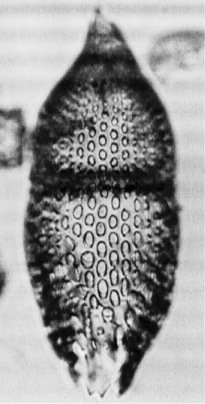 Podocyrtis
(Podocyrtoges) dorus Sanfilippo and Riedel
Podocyrtis
(Podocyrtoges) dorus Sanfilippo and Riedel Podocyrtis
(Podocyrtoges) dorus Sanfilippo and Riedel
Podocyrtis
(Podocyrtoges) dorus Sanfilippo and RiedelPodocyrtis (Podocyrtis) dorus Sanfilippo and Riedel, 1973, p.531, pl.35, figs.12-14
Podocyrtis (Podocyrtoges) dorus Sanfilippo and Riedel, 1992, p.14, pl.5, fig.3
Thorax pronouncedly inflated-conical, and lumbar stricture distinct. Pores aligned strictly longitudinally on both thorax and abdomen, those of the abdomen somewhat larger than those of the thorax, separated by longitudinal ridges. Abdomen tapers distally to a mouth at least as narrow as that in the specimen illustrated by Riedel and Sanfilippo (1970, pl.12, fig.5). Abdomen in some specimens short, as if compressed, narrowing abruptly rather than tapering distally. The poreless peristome bears a variable number of short triangular teeth, rather than three spathulate feet (Sanfilippo and Riedel, 1973).
Based on 35 specimens. Total length (excluding horn) 250-430 µm; length of cephalothorax 150-195 µm. Width of abdomen 155-205 µm (Sanfilippo, unpubl. data).
This form differs from Podocyrtis diamesa and P. phyxis in having the mouth more strongly constricted, and from the latter in having smaller pores (Sanfilippo and Riedel, 1973).
General form of shell inflated spindle-shaped, with the mouth narrow, surrounded by a variable number of small triangular teeth. Pores of thorax and abdomen longitudinally aligned, not large (Riedel and Sanfilippo, 1978a).
The pronouncedly inflated thorax, with pores aligned longitudinally and separated by longitudinal ridges is rather constant. The abdomen, however, is quite variable in length and in the degree of inflation, but always tapering to a constricted aperture. The thoracic pore rows, separated by longitudinal ridges, continue in the abdomen, but are variably expressed depending on the degree of inflation of the abdomen. Sometimes additional pore rows are inserted and thus the longitudinal alignment is offset. Maximum width of the abdomen usually medianly, but varies from proximally to distally (Sanfilippo, unpubl. data).
This species occurs in middle middle Eocene sediments from the Gulf of Mexico and the Caribbean. Its morphotypic last appearance lies within the Podocyrtis ampla Zone.
See under Podocyrtis (Podocyrtoges) diamesa herein.